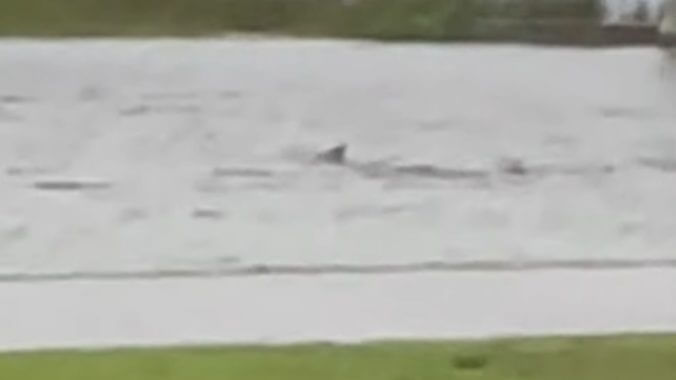The Hurricane Shark Meme Finally Became Real In 2022, And It Has A Lot To Say About Climate Change
Image via YouTube Tech Features memes
On Wednesday, September 28, as Hurricane Ian battered southwestern Florida, something extraordinary occurred. A meme crossed the digital divide into reality.
On that day, a man named Dominic Cameratta filmed a video of what appeared to be a shark swimming in his flooding Fort Myers neighborhood. The image went viral, and Storyful confirmed that Cameratta shot it when and where he claimed, leading to gleeful headlines and commentary across the internet.
“After over half a decade of debunking this hoax every time there was a flood or hurricane, I can’t believe I’m looking at an honest-to-god street shark,” journalist Jane Lytvynenko tweeted in response. “Good to finally meet you, pal.”
The image of a shark photoshopped into a flooded urban landscape has become a staple of the past decade of climate-change fueled superstorms. Snopes traced the first such manipulated image to a shark allegedly cruising down a Puerto Rican highway following flooding from Hurricane Irene in 2011. The shark in that photo was copy and pasted from a real image of a great white shark stalking a kayaker in 2005.
Since Hurricane Irene, the same shark has virtually traveled to the New York City subway system during 2012’s Hurricane Sandy, Florida’s Daytona Beach following 2016’s Hurricane Matthew, and Houston, Texas, following 2017’s Tropical Storm Harvey. Another variation on the meme circulated during Hurricanes Irma and Florence and saw images of the hurricanes themselves from space above doctored news headlines reading, “Irma/ Florence Now Contains Sharks: New Reports from NOAA Aircraft Show Sharks Have Been Lifted into Hurricane.”
The rise of the meme corresponded with both the emergence of the Sharknado franchise, launched in 2013, and growing awareness of how the climate crisis is making storms like Sandy, Harvey, and Florence wetter and more destructive.
Then came Ian, which was—according to an initial analysis—more than 10% wetter because of climate change as well as being Florida’s deadliest hurricane since 1935. It was also the storm that produced a real hurricane shark.
Or at least a real video of a shark-looking fish. There is still some uncertainty as to the identity of the fish Cameratta filmed. A Florida Fish and Wildlife Conservation Commission spokesperson told Storyful that the agency was “unable to identify the animal.” However, Florida Program for Shark Research Director Gavin Naylor told Paste that he was 80% sure the fish was a shark belonging to the
carcharhinid family.
“There’s a very characteristic notch at the top of the tail, which is a telltale signal for a carcharhinid shark,” Naylor said.
What’s more, certain shark species from this family are able to survive in brackish or freshwater. A type of carcharhinid shark called a bull shark was once found swimming around 1,000 miles up the Ohio River. The bull shark wasn’t pushed there by a storm. It was just looking for food. But large storms are another plausible reason why sharks would end up in unexpected places.
“When you have these big inundations with storm surge, especially when it’s in conjunction with tidal surges, you have large bodies of water that permeate the land mass and anything that’s in that body of water is going to move with it,” Naylor said.
As someone who educates the public about sharks, Naylor also has an idea as to why the hurricane shark meme caught on.
“I think that all children grow up thinking about monsters under the bed and some creature that might consume you and eat you,” Naylor said.
As we grow up, we realize the space beneath our beds is empty of frights, but the space beneath the “skin of the ocean” is anything but. Mysterious, occasionally dangerous animals like sharks fit into the space in our imaginations vacated by our childhood fears.
“It’s like, oh, the monsters that you were frightened of, they’re real and they’re in the ocean,” he said.
It’s also telling that the meme has been linked to the past decade of climate-fueled storms. The myth of technological advancement in the Western world since at least the industrial revolution is that innovation will allow us to protect ourselves from the uncontrollable elements of the natural world like weather disasters and wild predators.
Climate change and biodiversity loss have proven this to be a lie.
Our so-called advancements have only made the natural world more chaotic as capitalism bulldozes past the planetary boundaries within which human life evolved. Of course, we make sense of this moment by photoshopping the monsters under the ocean into the decade’s superstorms. It’s our imagination of the worst nature can do in revenge.
But does the meme’s foray into meat space mean that we have manifested our own nightmares by burning too many fossil fuels? Perhaps, or maybe, as Naylor points out, it’s just that more and more people now have smartphones to document unusual occurrences.
“If you’ve got enough people with iPhones, somebody eventually gets something that can be mapped to some meme that was generated several years previously,” he said.
It’s also important to note that, currently, humans are much more dangerous to sharks than sharks are to humans. An average of five people die in unprovoked shark attacks each year, while overfishing menaces one-third of shark and ray species with extinction.
One human activity that isn’t particularly threatening to sharks is climate change. They survived everything the Earth has thrown at them for around 400 million years, Naylor said. If nothing is done to reduce greenhouse gas emissions and sea levels continue to rise, it wouldn’t be unthinkable for “opportunistic animals” like sharks to move into newly submerged neighborhoods. So, it’s possible that we haven’t seen the last genuine hurricane shark.